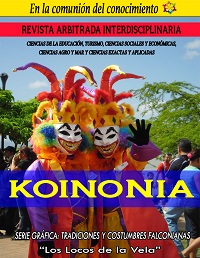Prediction of homicides from logistic regression in the metropolitan district of Quito, Ecuador
DOI:
https://doi.org/10.35381/r.k.v8i16.2551Keywords:
Homicide, mathematical models, operations research, (UNESCO Thesaurus)Abstract
The objective of the research is based on presenting the results of a prediction model of homicides from logistic regression in the metropolitan district of Quito - Ecuador. The research approach was quantitative with a descriptive scope. Step 7 indicates a Wald value of 9.284 and significance of 0.002 for the variable place where the homicide was committed (1), indicating 1 for the alternative "public road", with a value for Exp(B) of 0.08, so the model predicts that people have a probability of 0.08 of suffering a homicide on a public road compared to another place where they are. The model predicts that the public road is the place where there is the highest probability of homicide, equally for people of all ages, genders, nationalities.
Downloads
References
Abril-Donoso, M. E., Chariguamán Maurisaca, N. E., & Aguilar Reyes, J. E. (2022). Análisis de Correspondencias Múltiples para el Estudio de los Homicidios Intencionales en el Ecuador [Multiple Correspondence Analysis for the Study of Intentional Homicides in Ecuador]. Revista Politécnica, 50(3), 43–52. https://doi.org/10.33333/rp.vol50n3.04
Arias-Pérez, R, Espinosa-Montoya, T, Montoya-Gómez, B, & Botero-Bernal, M. (2021). Frecuencia del maltrato y homicidio infantil en Medellín (Colombia) [Frequency of child abuse and homicide in Medellin (Colombia)]. Medicina clínica y social, 5(1), 37-43. Epub April 00, 2021. https://doi.org/10.52379/mcs.v5i1.165
Barrera, A, Cabrera-Barona, P, & Velasco-Oña, P. (2022). Derechos, calidad de vida y división social del espacio en el Distrito Metropolitano de Quito [Rights, quality of life and social division of space in the Metropolitan District of Quito]. EURE (Santiago), 48(144), 1-23. https://dx.doi.org/10.7764/eure.48.144.05
Dugato, M., Calderoni, F., & Berlusconi, G. (2020). Forecasting Organized Crime Homicides: Risk Terrain Modeling of Camorra Violence in Naples, Italy. Journal of interpersonal violence, 35(19-20), 4013–4039. https://doi.org/10.1177/0886260517712275
Gelvez-Ferreira, J. D., Nieto-Rodríguez, M.-P., & Rocha-Ruiz, C.-A. (2022). Prediciendo el crimen en ciudades intermedias: un modelo de “machine learning” en Bucaramanga, Colombia [Predicting crime in intermediate cities: a machine learning model in Bucaramanga, Colombia]. URVIO. Revista Latinoamericana De Estudios De Seguridad, (34), 83–98. https://doi.org/10.17141/urvio.34.2022.5395
Giraldo-Alegría, S. A., Ordoñez Palacios, L. E., Bucheli Guerrero, V., & Ordoñez Erazo , H. (2020). Modelo de redes neuronales para predecir la tendencia de víctimas de secuestro en Colombia [Neural network model to predict the trend of kidnapping victims in Colombia]. Investigación E Innovación En Ingenierías, 8(3), 38–49. https://doi.org/10.17081/invinno.8.3.4702
Guarnizo-Chávez, A. J. (2022). Epidemiología y perfil médico legal de las muertes violentas en el Ecuador durante el estado de excepción, año 2020 [Epidemiology and medicolegal profile of violent deaths in Ecuador during the state of emergency, year 2020]. (Master's thesis). Retrieved from http://dspace.ucuenca.edu.ec/handle/123456789/40252
Meneses-Reyes, R, & Quintana-Navarrete, M. (2016). Homicidios e investigación criminal en México [Homicides and criminal investigation in Mexico]. Perfiles latinoamericanos, 24(48), 297-318. https://doi.org/10.18504/pl2448-012-2016
Molano, A., Harker, A., & Cristancho, J. C. (2018). Effects of Indirect Exposure to Homicide Events on Children's Mental Health: Evidence from Urban Settings in Colombia. Journal of youth and adolescence, 47(10), 2060–2072. https://doi.org/10.1007/s10964-018-0876-8
Monárrez-Fragoso, J. (2019). Feminicidio sexual sistémico: impunidad histórica constante en Ciudad Juárez, víctimas y perpetradores [Systemic Sexual Feminicide: A constant historical impunity in Ciudad Juárez, Victims and Perpetrators]. Estado & comunes, revista de políticas y problemas públicos , 1(8), 85-110. https://doi.org/10.37228/estado_comunes.v1.n8.2019.99
Otamendi, M. (2019). Juvenicidio armado: homicidios de jóvenes y armas de fuego en América Latina [Armed juvenicide”: youth homicides and firearms in Latin America]. Salud colectiva, 15, e1690. https://dx.doi.org/10.18294/sc.2019.1690
Swedo, E. A., Alic, A., Law, R. K., Sumner, S. A., Chen, M. S., Zwald, M. L., Van Dyke, M. E., Bowen, D. A., & Mercy, J. A. (2023). Development of a Machine Learning Model to Estimate US Firearm Homicides in Near Real Time. JAMA network open, 6(3), e233413. https://doi.org/10.1001/jamanetworkopen.2023.3413
Walker, B. B., Moura de Souza, C., Pedroso, E., Lai, R. S., Hunter, P., Tam, J., Cave, I., Swanlund, D., & Barbosa, K. G. N. (2020). Towards a Situated Spatial Epidemiology of Violence: A Placially-Informed Geospatial Analysis of Homicide in Alagoas, Brazil. International journal of environmental research and public health, 17(24), 9283. https://doi.org/10.3390/ijerph17249283
Published
How to Cite
Issue
Section
License
Copyright (c) 2023 Marco Iván Chávez-Cadena, Mauricio Enrique Abril-Donoso

This work is licensed under a Creative Commons Attribution-NonCommercial-ShareAlike 4.0 International License.
CC BY-NC-SA : Esta licencia permite a los reutilizadores distribuir, remezclar, adaptar y construir sobre el material en cualquier medio o formato solo con fines no comerciales, y solo siempre y cuando se dé la atribución al creador. Si remezcla, adapta o construye sobre el material, debe licenciar el material modificado bajo términos idénticos.
OAI-PMH URL: https://fundacionkoinonia.com.ve/ojs/index.php/revistakoinonia/oai.









